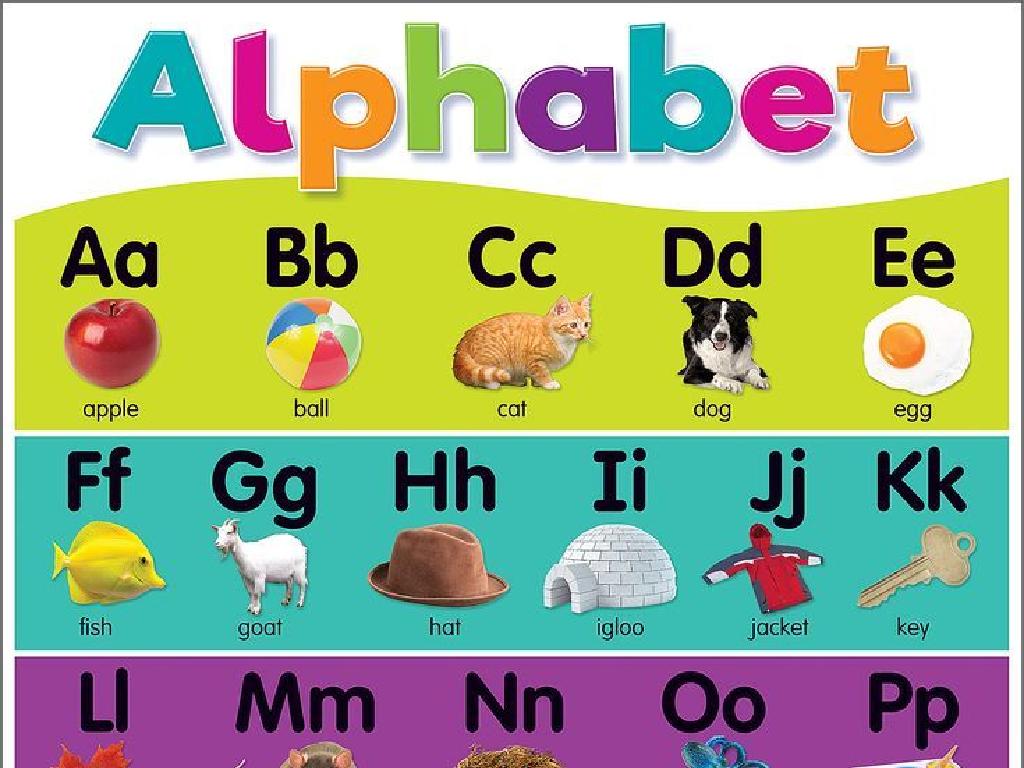Unit Rates
Subject: Math
Grade: Seventh grade
Topic: Ratios, Rates, And Proportions
Please LOG IN to download the presentation. Access is available to registered users only.
View More Content
Welcome to Unit Rates!
– Understanding ratios and rates
– Ratios compare two quantities, rates compare different units.
– Defining a unit rate
– A unit rate describes how many units of the first type of quantity corresponds to one unit of the second quantity.
– Real-life unit rate examples
– Miles per hour in driving, price per item when shopping.
– Applying unit rates
– How to use unit rates to make informed decisions and solve problems.
|
This slide introduces the concept of unit rates within the broader topics of ratios, rates, and proportions. Begin by explaining ratios as a comparison of two quantities and rates as ratios that compare different units. Then, define a unit rate as a type of rate with a denominator of one unit. Provide relatable examples such as driving speed (miles per hour) and shopping prices (cost per item) to illustrate the concept. Emphasize the practicality of unit rates in everyday decision-making and problem-solving. Encourage students to think of additional examples and to practice calculating unit rates from various scenarios.
Understanding Ratios
– Define a ratio
– A ratio shows the relative sizes of two or more values.
– Ratios in daily life
– Examples: recipe ingredients, speed (miles/hour), price comparisons.
– Writing ratios
– Ratios can be written by using words, as fractions, or with a colon, like 3 to 4, 3/4, or 3:4.
– Ratio forms: words, fractions, and colon
|
Introduce the concept of ratios, which are a way to compare quantities to each other. Use relatable examples such as ingredients in a recipe (e.g., 2 cups of flour to 1 cup of sugar), speed (miles per hour), or comparing prices (dollars per pound). Explain that ratios can be written in different forms but represent the same comparison. Emphasize that understanding how to write and interpret ratios is crucial for solving problems in everyday life and in more complex math. Encourage students to think of their own examples and to practice writing them in different forms.
Introduction to Unit Rates
– Define a unit rate
– A rate comparing two different units, like miles per hour.
– Difference from ratios
– Ratios compare two quantities of the same unit; rates compare different units.
– Everyday examples of rates
– Speed of a car, price of an item per ounce.
– Calculating unit rates
– Divide the total quantity by one unit to find the rate.
|
Begin the lesson by defining a unit rate and how it is a special type of rate that compares a quantity to one unit of another quantity. Clarify the distinction between ratios and rates, emphasizing that ratios compare similar quantities, while rates compare different units. Provide relatable examples such as the speed of a car (miles per hour) or the price of goods (cost per ounce). Teach students how to calculate unit rates by dividing the total quantity by one unit, which is a critical skill for comparing different situations and making informed decisions. Encourage students to think of additional examples and to practice calculating unit rates with various problems.
Exploring Unit Rates
– Defining uniqueness of Unit Rates
– A unit rate describes how many units of the first type of quantity corresponds to one unit of the second type of quantity.
– Steps to calculate Unit Rates
– Divide the total quantity by the number of items to find the rate per one unit.
– Comparing items with Unit Rates
– Use unit rates to compare costs, speeds, or efficiency of different items or scenarios.
– Real-world application
|
Unit rates are a fundamental concept in understanding ratios and proportions, especially in real-world applications. They allow us to compare different items or scenarios on a common scale, such as price per item or miles per hour. When teaching this concept, emphasize the process of dividing the total quantity by the number of items to find the rate for a single unit. This simplifies comparisons and decision-making in everyday situations, such as shopping or traveling. Provide examples like comparing prices of different brands of the same product or the speed of different animals or vehicles. Encourage students to practice calculating unit rates from various scenarios to gain proficiency.
Calculating Unit Rates
– Steps to find unit rates
– Divide the total by the number of items to find the rate for one
– Example: Miles per hour
– If you drive 150 miles in 3 hours, the unit rate is 50 miles per hour
– Example: Price per item
– For 10 apples costing $5, the unit rate is $0.50 per apple
– Practice: Calculate a unit rate
– Find the unit rate: 200 pages in 4 hours
|
This slide introduces the concept of unit rates, which are a comparison of two different quantities when one of the quantities is one. Start by explaining the step-by-step process of calculating unit rates, which involves dividing the total amount by the number of items. Use relatable examples like calculating the speed of a car in miles per hour or the price of an item when given a total cost. Provide a practice problem for students to solve, such as finding the unit rate of pages read per hour. This will help solidify their understanding through application. Encourage students to think of other examples of unit rates they encounter in daily life.
Unit Rates in the Real World
– Unit rates aid decision making
– Compare grocery store products
– Price per ounce or liter helps determine the best deal
– Understand and interpret speed limits
– Miles per hour informs us how fast we can go safely
– Apply unit rates in daily life
|
Unit rates are a practical tool in everyday decision making, allowing us to compare different items and understand various measures. When shopping, students can use unit rates to compare prices and get the best value for their money. Understanding speed limits as unit rates helps students grasp the concept of speed as a rate over time, promoting safe driving habits. Encourage students to think of other examples where they use unit rates in their daily lives, such as comparing fuel efficiency of different vehicles or calculating the cost of electricity per kilowatt-hour. This will help them see the relevance of math in real-world contexts.
Class Activity: Let’s Find Unit Rates!
– Activity: Find the best buy
– Work in pairs or small teams
– Use grocery flyers for comparison
– Compare unit prices of products to determine the most cost-effective option.
– Discuss findings with the class
– Share which product offers the best value for money and why.
|
This activity is designed to apply the concept of unit rates to a real-world scenario: shopping for groceries. By working in pairs or small teams, students will engage in collaborative learning to compare the prices of different products using grocery store flyers. The goal is to find the unit price of each item and determine which product offers the best value. This will help students understand how unit rates are used in everyday life and enhance their decision-making skills. Provide guidance on how to calculate unit rates and encourage discussion among groups to facilitate peer learning. After the activity, have each group share their findings and explain their reasoning to the class. Possible variations of the activity could include comparing different brands, sizes, or even stores.
Unit Rates: Review and Q&A
– Recap of unit rates concept
– A unit rate compares a quantity to one unit of another quantity, like miles per hour.
– Encourage student questions
– Address doubts and confusions
– Reinforce learning with examples
– For instance, if a car travels 300 miles in 5 hours, the unit rate is 60 miles per hour.
|
This slide is aimed at revisiting the concept of unit rates and ensuring students have a solid understanding. Begin with a brief recap, explaining that a unit rate is how we compare two different quantities. Encourage students to ask any questions they have about unit rates, providing a safe space for them to express their uncertainties. Address any doubts by giving clear explanations and additional examples if needed. Use real-life scenarios, such as speed in miles per hour or price per item, to make the concept more relatable. The goal is to solidify their comprehension and to prepare them for applying unit rates in various contexts.
Homework: Mastering Unit Rates
– Complete practice problems on unit rates
– Study for the upcoming quiz on ratios and unit rates
– Find real-life unit rate examples at home
– Look for unit rates in grocery shopping receipts, recipes, or bills
– Be ready to discuss your examples in class
|
This homework assignment is designed to reinforce students’ understanding of unit rates through practice and real-world application. Encourage students to complete the set of practice problems to solidify their grasp of the concept. They should also review their notes and textbook examples to prepare for the quiz on ratios and unit rates. Additionally, students are tasked with finding examples of unit rates in their daily lives, such as the cost per ounce of different food items or the speed per hour while traveling. This will help them see the relevance of unit rates beyond the classroom. In the next class, students will have the opportunity to share and discuss their findings, promoting peer learning and engagement with the material.





